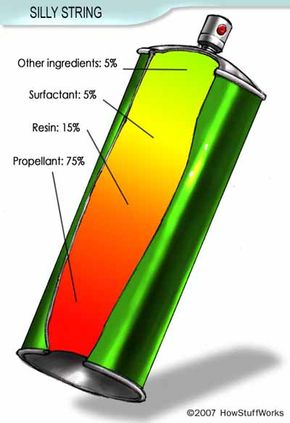The Environmental Impact of Silly String
About 75 percent of the liquid inside of a can of Silly String is propellant. You release this propellant into the air when you press down on the nozzle. Considering that its original propellant was an ozone-depleting substance, it's no surprise that it got the attention of the United States Environmental Protection Agency (EPA) and other regulatory agencies. Many regulations governing ozone-depleting substances issued in the 1970s and 1980s specifically reference Silly String and prohibit its use.
Today, CFCs and hydrochlorofluorocarbons (HCFCs) are banned for use in non-essential applications. For this reason, Silly String and other aerosol products use other propellants. That doesn't mean all Silly String is safe for the environment, though. In 1989, regulatory agencies discovered banned substances in Silly String sold in Woolworths in the United Kingdom. Authorities also discovered CFC-containing spray string in Canada in 2002.
Advertisement
In September of 2006, the EPA learned that five American companies were selling spray string that contained banned HCFCs. The cans had all been imported from China and Taiwan, and authorities believe that most of their ozone-depleting compounds had already been released into the atmosphere before anyone realized anything was amiss. Once the EPA discovered the banned substances, the agency confiscated the remaining cans and incinerated them using a procedure that destroyed the HCFCs.
Its large proportion of propellant can also give Silly String two seemingly opposite hazards. Some propellants are flammable, and others become so cold when leaving the container that they can freeze a person's skin. Most can labels include warnings about whether the string inside requires specific precautions, and many specify to avoid heat and open flames. But some formulations of the product have been dangerous enough to cause widespread concern. For example, in 1990, the United States Consumer Product Safety Commission (CPSC) issued a recall for a variety of spray string that used a highly flammable propellant.
Some municipal authorities are also worried about Silly String for a very practical reason. Sprayed string can make a mess. Several cities have banned the use of Silly String during celebrations, at parades and on holidays like Halloween. In addition to being hard to remove from concrete and brick, the strands are essentially sticky plastic, so they can clog storm drains and take up space in landfills.
Silly String's long-lasting popularity makes it unlikely that safety or environmental concerns will cause it to disappear from shelves anytime soon. To learn more about aerosols, Silly String and related topics, check out the links below.
Related HowStuffWorks Articles
More Great Links
Sources
- United States Patent and Trademark Office Patent # 3705669 http://patft.uspto.gov/netacgi/nph-Parser?Sect1=PTO2&Sect2= HITOFF&p=2&u=%2Fnetahtml%2FPTO%2Fsearch-bool.html&r= 90&f=G&l=50&co1=AND&d=PALL&s1=wham-o&OS= wham-o&RS=wham-o
- United States Patent and Trademark Office Patent # 2757957 http://patft.uspto.gov/netacgi/nph-Parser?Sect1=PTO2&Sect2= HITOFF&p=1&u=%2Fnetahtml%2FPTO%2Fsearch-bool.html&r=2&f=G&l=50&co1= AND&d=PALL&s1=samann&s2=julius&OS=samann+AND+julius&RS =samann+AND+julius
- United States Patent and Trademark Office Patent # 3065915 http://patft.uspto.gov/netacgi/nph-Parser?Sect1=PTO2&Sect2= HITOFF&p=1&u=%2Fnetahtml%2FPTO%2Fsearch-bool.html&r=1&f= G&l=50&co1=AND&d=PALL&s1= samann&s2=julius&OS=samann+AND+julius&RS=samann+AND+julius
- Newton Ask a Scientist: Silly String http://www.newton.dep.anl.gov/askasci/chem03/chem03633.htm
- United States Environmental Protection Agency: Class 1 Nonessential Products Ban. January, 1993. http://www.epa.gov/ttn/caaa/t6/fr_notices/105.txt
- EPA. "EPA Reaches Agreement with Tween Brands on Clean-air Violations." 12/4/2006. http://yosemite.epa.gov/opa/admpress.nsf/a8f952395381d3968525701c 005e65b5/80dd0db3ab9e22b88525723a006527a2!OpenDocument
- EPA: Confetti String Clean Air Orders. http://www.epa.gov/compliance/resources/cases/civil/caa/ confettistring.html
- BBC: Silly String. http://www.bbc.co.uk/cult/ilove/years/1969/toys1.shtml
- Wham-O: History Timeline
- AP. "String Confetti Aerosol Cans Are Recalled as Fire Hazards." New York Times. 1/29/1990. http://query.nytimes.com/gst/fullpage.html?res= 9C0CE5DC123FF93AA15752C0A966958260
- United States Patent and Trademark Office. Trademark Assignment Assignee Details. Just for Kicks. http://assignments.uspto.gov/assignments/q?db=tm&asned= JUST%20FOR%20KICKS,%20INC.
- Santana, Rebecca. "String May Be Silly, But it Saves U.S. Lives in Iraq." The Seattle Times. 12/7/2006. http://seattletimes.nwsource.com/html/nationworld/ 2003465472_iraqstring07.html
- Society of the Plastics Industry. "Definitions of Plastic Resins." http://www.socplas.org/industry/defs.htm
- Vorderstrasse, Aaron. "Dichlorodifluoromethane." http://www.wou.edu/~avorder/Refrigeration.htm
